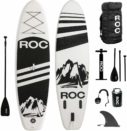This is a conversation that many water sports fans are having nowadays. The waves no longer belong solely to the surf bros. Though many surfers welcome SUP boarders and even grab a paddle themselves, others resent the influx of outsiders to their waters. Some consider classic surfing superior to SUP.
With the rising popularity of SUP and its similarity to surfing, people are growing more and more curious about surfboarding vs. paddle boarding. Questions such as “can you surf on a paddleboard?”, “what’s the difference between a surfboard and paddleboard?” and “is SUP easier than surfing?” are floating around these days. Here, we give six reasons why some might choose SUP over surfing.
- Mobility: Using a paddle to help propel you to better waves is much easier than lying on your stomach and paddling with your arms, which is required on a traditional surfboard. And, when you do find the sweet spot, actually catching the wave is more attainable on a paddleboard than on a regular surfboard.
- Accessibility: Though SUP boarding can be a rigorous workout, anyone can stand up on one. It’s effortless to moderate the amount of exertion. The young, old, even those with injuries and special needs can all do it. So, the answer to the question, “Can you surf on a SUP board?” is YES. If you can stand, you can SUP surf.
- Versatility: SUP boards are designed to serve many different purposes. There’s a wide variety of activities you can do on a SUP, from hauling camping gear to fishing and even yoga. The size and weight of the board allow for more versatility. Plus, the SUP board’s added volume makes it easier to catch waves.
- Physicality: SUP boarding is a solid core workout. Unlike a kayak, where you are sitting the whole time, SUP utilizes the entire body. Gliding across the waves on a SUP requires balance and attention the whole time you are on the board, so the overall workout is very beneficial. The amount of energy exerted on the water is another significant difference between surfboard and paddleboard. Surfing is a workout in its own right. But most of the time, you are sitting waiting for a wave, with small bursts of energy in between. This doesn’t compare to the long term physicality of being on a SUP.
- Visibility: The “S” in SUP is essential, because the ability to STAND on water unencumbered is a thrill, unlike any other. You can see all your surroundings and profoundly connect with the ocean, as you view all that’s above and below you. Plus, it’s great for spotting nice surf breaks from afar.
- Possibility: Finally, the possibilities of a SUP are endless. You can go anywhere. You can paddle up canals, battle rapids, glide across calm lakes, and even explore unsubmerged caves on a paddleboard. If there is water, you can SUP. A significant difference between surfboard and paddleboard is SUP can take you places a surfboard just can’t.





